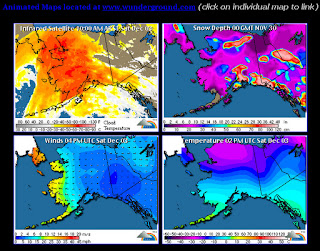 |
| Alaska Weather via Weather Underground |
One of the many weather extremes we deal with here in Alaska is wind. It's not uncommon for places in southern Alaska to see winds exceeding 100 Mph. For my area, winds in excess of 80 Mph is not uncommon, especially during the winter months. We seem to be in this repetitive pattern lately of Chinook systems moving in from the south creating strong winds. This was the case about a week ago. I live inside the northern shadow of Mount Healy, so I don't get the full effect of these south east winds however, I get my share. With the storm pictured here, we saw wind gusts to 65 Mph at my QTH on December 3rd and 4th. As any ham knows, wind does not play well with any type of outdoor antenna. Just knowing we had these weather patterns made me purchase the Hazer system for my Rohn 25 tower.
 |
| December Chinook covering most of Alaska |
Having the ability to lower my beam and wire antennas helps me sleep at night when we receive these types of weather patterns. The maps at the right are from Weather Underground and I specifically use the Infrared map to track these systems as they approach Alaska. Since living here, this last Chinook was probably one of the strongest we have encountered yet. These will normally last 48 hours before moving eastward. I lowered my antenna to the roof level with the approach of this system. Since I use my Hazer to attach the apex of my wire antennas, a few of these antennas will actually lay on my roof. With storms like this, we will see dramatic temperature changes as the wind brings warmer air! We can go from -25F to +40F in a matter of hours! With this storm system, we received the wind, then as it started to die down, we received rain, followed by brief freezing rain and then snow. It was not long before 12 inches of fresh snow blanketed the area. This left a nice layer of ice underneath all that fresh snow.
 |
| Extreme gust close to my QTH |
When it was time to send the beam back up the tower, I found that the resting foot of my Hazer was frozen and I was unable to release it so I could move it upward. I also found my hand crank was frozen, too. Thankfully I keep on hand a few cans of de-icer and with my XYL's help, about 45 minutes later, I was able to send the Hazer skyward. But, my problems did not stop there. My wire antennas were laying on my roof underneath 12 inches of snow and laying in a layer of ice! I also had one leg of my 40 meter inverted V wrapped around several branches in a nearby spruce tree. It took us awhile to get the antennas freed from trees and out from the ice but thankfully we were successful. The antenna was only up for a day and a half before the next system arrived early this week. Needless to say, down came the antennas once again.

No comments:
Post a Comment